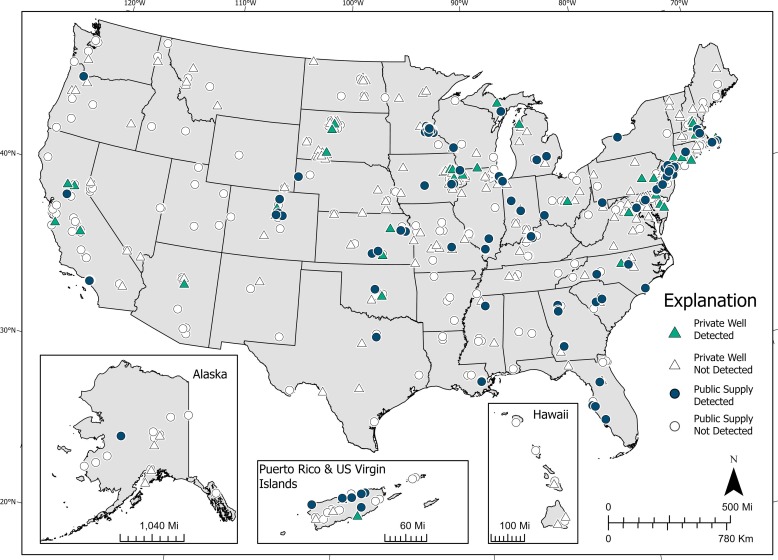7/5/23 – 45% or more US Water contains PFAS!
7/5/23 – 45% or more US Water contains PFAS!
7/5/23 – 45% or more US Water contains PFAS!

“At least 45% of the nation’s tap water is estimated to have one or more types of the chemicals known as per- and polyfluorinated alkyl substances, or PFAS, according to a new study by the U.S. Geological Survey. There are more than 12,000 types of PFAS, not all of which can be detected with current tests; the USGS study tested for the presence of 32 types.” – USGS
PFAS is becoming a REAL ISSUE! Currently, there are not yet any federally enforceable standards for PFAS in drinking water in the United States but the U.S. Environmental Protection Agency (EPA) has begun developing a national primary drinking water standard for PFOA and PFOS and is considering ways to evaluate additional PFAS.
“Trace doses of several of the most-researched compounds have been linked to health issues from cancers and increased cholesterol levels to preeclampsia during pregnancy.3 Scientific research shows that PFAS affect the immune, endocrine and metabolic systems. 4, 5, 6, 7 But very little is known about a majority of PFAS, including how long they linger in our bodies (referred to as half-life), their toxicity and how different PFAs may interact in our bodies.
Research into the potential health implications of PFAS indicates reason for concern. Perfluorooctanoic acid (PFOA), one of the most well-studied PFAS, has been linked to kidney and testicular cancer, 8, 9, 10 decreased antibody responses to vaccines, 11 liver damage, increased cholesterol levels,10 increased risk of thyroid disease, 10 increased risk of decreased fertility, decreases in birth weight, 12 and increased risk of pregnancy-induced hypertension and preeclampsia.10, 13 This evidence of harmful health effects led to the phasing out PFOA and perfluorooctanesulfonic acid (PFOS) in the United States.14
This USGS research marks the first time anyone has tested for and compared PFAS in tap water from both private and government-regulated public water supplies on a broad scale throughout the country. Those data were used to model and estimate PFAS contamination nationwide. This USGS study can help members of the public to understand their risk of exposure and inform policy and management decisions regarding testing and treatment options for drinking water.” – Center for Scientific Responsibility and Justice
PFAS are a group of synthetic chemicals used in a wide variety of common applications, from the linings of fast-food boxes and non-stick cookware to fire-fighting foams and other purposes. High concentrations of some PFAS may lead to adverse health risks in people, according to the U.S. Environmental Protection Agency. Research is still ongoing to better understand the potential health effects of PFAS exposure over long periods of time. Because they break down very slowly, PFAS are commonly called “forever chemicals.” Their persistence in the environment and prevalence across the country make them a unique water-quality concern.
“USGS scientists tested water collected directly from people’s kitchen sinks across the nation, providing the most comprehensive study to date on PFAS in tap water from both private wells and public supplies,” said USGS research hydrologist Kelly Smalling, the study’s lead author. “The study estimates that at least one type of PFAS – of those that were monitored – could be present in nearly half of the tap water in the U.S. Furthermore, PFAS concentrations were similar between public supplies and private wells.”
The EPA regulates public water supplies, and homeowners are responsible for the maintenance, testing and treatment of private water supplies. Those interested in testing and treating private wells should contact their local and state officials for guidance. Testing is the only way to confirm the presence of these contaminants in wells. For more information about PFAS regulations, visit the EPA’s website on addressing PFAS.
The study tested for 32 individual PFAS compounds using a method developed by the USGS National Water Quality Laboratory. The most frequently detected compounds in this study were PFBS, PFHxS and PFOA. The interim health advisories released by the EPA in 2022 for PFOS and PFOA were exceeded in every sample in which they were detected in this study.
Scientists collected tap water samples from 716 locations representing a range of low, medium and high human-impacted areas. The low category includes protected lands; medium includes residential and rural areas with no known PFAS sources; and high includes urban areas and locations with reported PFAS sources such as industry or waste sites.
Most of the exposure was observed near urban areas and potential PFAS sources. This included the Great Plains, Great Lakes, Eastern Seaboard, and Central/Southern California regions. The study’s results are in line with previous research concluding that people in urban areas have a higher likelihood of PFAS exposure. USGS scientists estimate that the probability of PFAS not being observed in tap water is about 75% in rural areas and around 25% in urban areas.
– Content from US Geological Survey 2023

